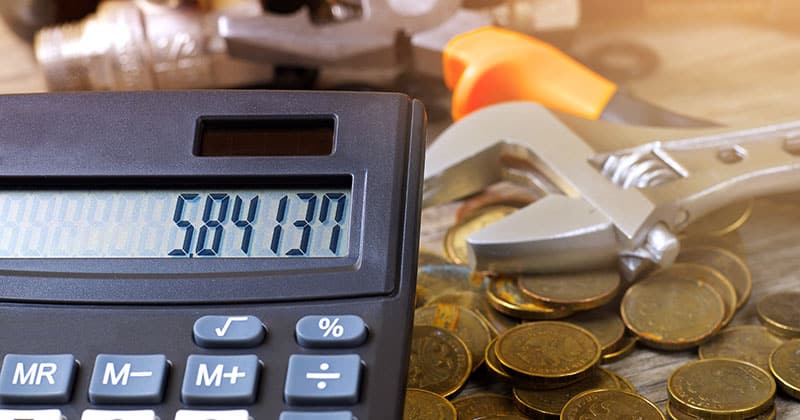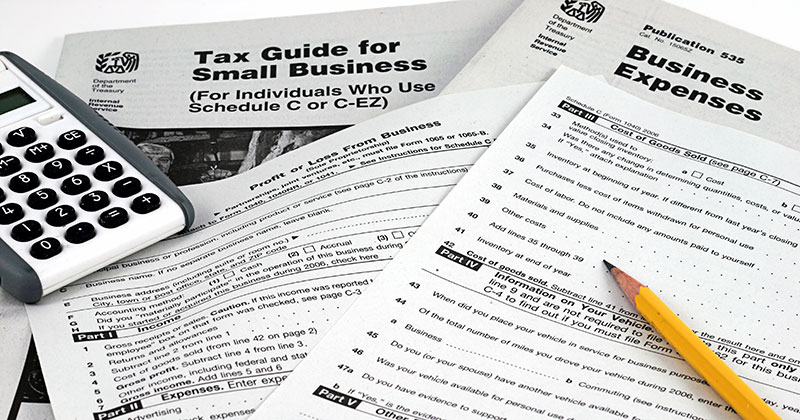
Organizing finances is an essential part of any business. Accounting for plumbing businesses is no exception.
While most of your work may be fixing customers’ issues, you should also spend time on your finances. Accounting will allow you to plan for your business, plot its growth, and make contingency plans for leaner times.
This article will explain accounting for plumbing businesses to help yours grow and thrive.
We’ll start by describing how to forecast for a plumbing business. This will help you plan for peaks and troughs in activity and cash flow.
Then, we’ll create a plumbing business budget. This will list the steps you need to take to devise a realistic budget.
We’ll also look at analyzing your costs as a plumber, tax considerations, and some helpful accounting strategies. Plus, we’ll introduce software that can help plumbers with accounting. This helps streamline paperwork and keep you on track with your financial activities.
Ready to find out more about accounting for plumbing businesses in our easy how-to guide?
Let’s get started.
How To Forecast for a Plumbing Business
Accounting for your plumbing business starts with forecasting. This is the practice of predicting how your business will flow based on revenue, expenses, and cash flow data.
Forecasting helps you understand how much your business will likely make within a given period. You’ll also be able to estimate how much you’re likely to spend.
This information is essential to help you budget and plan for your business and allows you to make informed business decisions.
Forecasting is also an essential part of growing your business. For example, it can help reassure lenders that your business will be profitable in the future.
Check out these strategies to help you forecast your plumbing business.
Create a Forecast Manually
You can manually create a forecast using a spreadsheet such as Excel or Google Sheets.
In Excel, for example, the FORECAST (also called FORECAST.LINEAR) function allows you to predict a future value following a linear trend.
Or you can use the FORECAST.ETS function, which takes seasonal ups and downs into account.
This method can provide a realistic forecast but does require you to input data manually to start with.
If you’re confident with your data input and basic accounting skills, this could be an option for you.
Hire a Financial Consultant or Accountant
When you hire a financial consultant or accountant to create your forecast, you can relax knowing that the task is in the hands of a professional.
This can be a good option if you don’t feel confident enough to create a forecast yourself.
Choose a professional with experience in the plumbing field who knows the challenges of your business.
Of course, you will need to pay a fee for this service. And remember that your forecast is an ongoing part of business planning, so you’ll need to update it regularly.
But as long as you can afford it, hiring a financial professional can bring peace of mind.
Invest in Plumbing Software
Software allows you to create a forecast without having to worry about errors or invest too much of your precious time.
Choose a package that either includes a forecasting tool or integrates with the accounting system you already use.
With the right software, you’ll get a fully formed forecast to discuss at team meetings or share with your bank or investors. You’ll also be able to track your performance against your forecast and adjust if necessary.
One of the main benefits of this option is that it’s cost-effective compared to hiring a financial consultant.
It’s also a more streamlined approach to creating a forecast than inputting data manually into a spreadsheet.
RELATED: The Best Small Business Field Service Management Software Has These Features.

Creating a Plumbing Business Budget
Your budget estimates your upcoming expenses and income. It helps you keep track of your goals and hit financial targets.
Your budget will also enable you to manage your cash flow, monitor any debts, and prepare for emergencies.
You’ll need to follow a series of steps to create your plumbing business budget. We’ve summarized them below for you.
1. Identify Your Revenue
Examine all your income sources to understand how much cash you have flowing into your business every month. Then, look for patterns.
Do you notice any peaks or troughs in your income? Maybe you can see that business is slow in the lead-up to the holiday season. Or that it picks up during the colder months when problems like frozen pipes or broken-down boilers can be a real problem.
It’s essential to identify these patterns in your budget to help you plan for leaner times and make projections for the future.
2. Subtract Fixed Costs
Next, you’ll need to add up all your fixed costs. These are the ones that stay the same month after month.
They include items like:
- Salaries
- Rent
- Loan repayment
- Taxes
- Insurance
Now, subtract the sum of your fixed costs from the revenue identified in Step 1.
3. Subtract Variable Costs
As you gather your fixed costs, you’ll notice that other fees may change from month to month. These are your variable costs.
Variable costs may include:
- Raw materials
- One-off equipment costs
- Owner’s salary (if it varies according to profit made)
- Employees’ overtime costs
Once you’ve gathered this information, you can also subtract it from your revenue.
4. Create a Contingency Fund
By now, you’ll know how much cash you have left after subtracting fixed and variable costs from your revenue.
You should set aside some of this surplus as your contingency fund.
Knowing that you can replace a kit if it breaks down will give you peace of mind.
5. Calculate Your Profit
Once you’ve calculated your expenses and deducted these amounts from your revenue, you’re left with your monthly net income.
If it’s positive, you’ve made a profit. If it’s negative, you’re running at a loss. This is normal for small businesses some months, especially when they’re starting out.
Identifying this information can help you understand whether you need to reduce expenses, drum up more business—or both.
At this point, you will have a clear picture of how your business is doing and how to budget going forward.
FROM ONE OF OUR PARTNERS: 7 Budgeting Tips to Make This the Best Year for Your Business

Analyzing Your Costs as a Plumber
Knowing where your money is spent is crucial to managing your budget and working towards a profit.
Understanding your costs also helps you price your services so that you make a profit while offering a fair price to your customers. This is a vital part of your business strategy, helping you to gain trust and improve retention rates.
These are just a few good reasons to understand your costs as a plumber. We’ll show you how in this section.
Understand Your Expenses
As part of your budgeting exercise, you will already have listed your fixed and variable costs. This means you’ve already done the groundwork in understanding your expenses.
You can analyze those expenses by taking a closer look at the data you’ve gathered.
Start by categorizing them into sections such as salaries, fuel, utilities, rent, and equipment. Now, you should be able to see at a glance how your expenses are allocated.
Use Visual and Other Tools for Further Analysis
Take your analysis one step further using visual and other tools to understand precisely how your expenses are allocated.
A simple pie chart can show which category of expenses is the costliest.
You can also use visual tools like a bar chart to show your monthly expenses. This will help you track seasonal changes or identify other trends in expenditure.
Or go one step further and use business management software to analyze your costs. This provides a seamless way to see where your costs are going at a glance.
Having clear information at your fingertips means you can plan for your business.
Work Out the Cost of Your Time
Knowing the value of your time is an essential factor in analyzing your costs. It also helps you price jobs fairly for both you and your customers.
Figure out your hourly rate. Divide your total costs by the number of hours you spend doing plumbing work each month.
You can also work out a flat-rate cost for jobs. You can do this by calculating how long a job is likely to take and using your hourly rate to offer a flat rate to customers.
Now that you’ve analyzed the cost of your time, you will have the correct information at your fingertips to respond quickly to your customers.
How Software Can Help Plumbers with Accounting
We’ve already seen that creating forecasts and budgets and analyzing costs can generate paperwork.
If you’re running a busy plumbing business, then you won’t have a lot of time to dedicate to this. And employing someone to take care of this role can be costly.
That’s where software specially designed for plumbing businesses comes in. The best packages for small businesses offer a range of features to simplify your activities. They will also give you a clear picture of your performance.
Let’s find out more about the benefits of software for plumbing businesses.
Track Your Invoices
Keeping cash flowing is an important part of running your business smoothly.
Accounting software for plumbing businesses allows you to track your invoices. This means that you know at a glance which payments are due and which need chasing.
No more searching through paper or digital files for the information you need. It’s collated in one place with the right software package for your plumbing business.
Digital Payments
Software for plumbing businesses also allows you to keep cash flowing with digital payment methods.
With Service Fusion, for example, you can generate a digital invoice and offer FusionPay to collect payment online via an app or by using a customer’s card on file.
This is convenient for both you and your customers. Your customers will love the no-hassle method of paying, which means you’re more likely to get paid on time and retain business.
Instead of wasting your valuable time chasing late payments, you can focus on growing your business and making it even better.
Financial Reporting
A software package that links to your existing accounting system, such as QuickBooks, makes life much easier.
It means you can rely on a single system to manage all areas of your business activities.
You don’t have to click in and out of different systems to input data. Instead, it’s all available on a single interface, offering a straightforward understanding of your financial position.

Tax Considerations for Plumbers
Keeping on top of your taxes may not be the most exciting part of your business—but it’s undoubtedly one of the most important.
Think of it as the foundation of a successful plumbing business. When it’s strong, all other aspects of running your company are more likely to be successful.
You won’t have to worry about rushing to meet your tax deadline or whether you’ve got funds to pay your dues.
Check out the following three tips to help you manage your taxes.
Dedicate Time to Taxes
Set aside time to work on your taxes all year round, not just when deadlines approach. This will help you feel in control of your affairs.
These days, keeping on top of your taxes doesn’t have to be complicated. As we’ve seen, software packages can take the hard work out of tax planning and offer a user-friendly way to keep ahead of your paperwork.
Pay as You Go
In the United States, you must pay income tax “as you go” rather than in one lump sum on April 15. So, as a business owner, your taxes will be due quarterly.
This means you must keep up to date with what you owe and ensure you have money set aside to cover payments. The best way to do this is to use accounting for plumbing business software that allows you to track your income with ease.
You will be able to see clearly how much you owe and schedule payments, so you don’t get hit with penalties for late payments.
Understand Business Deductions
Knowing which items can be counted as deductions can save you money in the long run.
You probably already know that items like wages and equipment purchases can count as expenses. But take the time to ensure you’re up to date with the complete list of business expenses. You can check out the complete list on the IRS website.
And know that the right software will help you record all eligible expenses as you go along. This will make filing your tax return a straightforward task.
FROM ONE OF OUR PARTNERS: 10 Tax Laws to Know for Your Small Business
Where to Start with Accounting for Plumbing Businesses
It’s time to try out some quick and easy ways to start organizing your accounting affairs for your plumbing business.
- Understand whether you’re making a profit or loss. List all your revenue and your expenses month by month. Deduct your expenses from your income and see what you’re left with. This is the first step in knowing how your business is doing.
- Schedule essential dates in your calendar. Include tax payment deadlines, when payments are due, and employees’ pay dates. This will help you feel in control of your financial matters.
- Get a free demo of plumbing business management software that helps with your accounting. It will give you an understanding of how investing in the right software package could save you time, money, and effort.
Related Posts
Stay Informed
Get the latest news and insights plus, Service Fusion offers and updates.Thank you for your submission.
SHARE